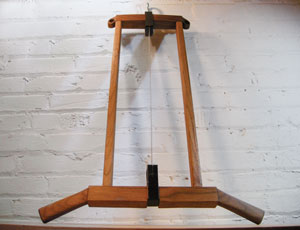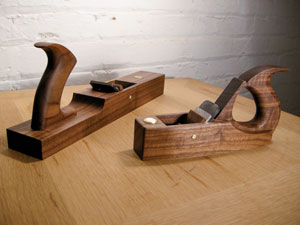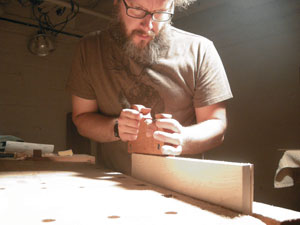
Tom Fidgen is an “unplugged” woodworker: hand tools all the way.
That’s a conscious choice, one he made after moving to Toronto, Ontario, in 2008, leaving behind a boat building business in Cape Breton, Nova Scotia. In the six to 12 weeks it would take him to build a boat, Tom said, he’d be spending so much time with power tools, sanding and chemicals — “really toxic stuff” — that tackling the remaining bits of dry wood with hand tools at the end of a boat project was a welcome “break from the dust and the noise.”
When he moved from Cape Breton to Nova Scotia in 2008, after the recession hit and “everybody put their wallets away,” he “left all the power tools behind.” In part, that was because moving to the city was expensive, and he knew he could get away with a smaller shop space if he only used hand tools.
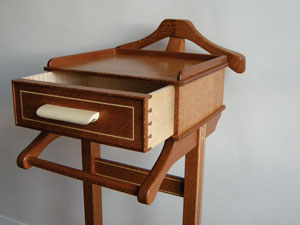
He ended up with a 12′ x 12′ shop in his basement. “My workbench is in the middle, and that’s all the room you need,” Tom said. It also gives him the opportunity to incorporate both of his careers. Tom has been a professional musiciansince 1993; his music and his woodworking “weigh on each other,” he said. “After a morning of sweating and sawing and planing, on my break time, I’ll go upstairs and pick up the guitar and play. Then with music, if I’m working on a large project, like if I’m recording something, I’ll want to get away from that and back to woodworking.”
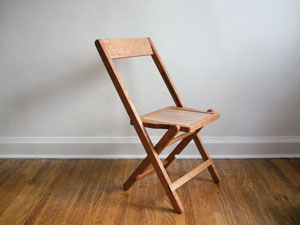
Tom, whose most recent CD, released in 2011, is entitled “a boy called fish,” noted that “most professional musicians have a day job,” and that his has always been working with wood. Prior to building boats, he did set design, which taught him a lot about different styles, although everything needed to be faux and able to be disassembled. “Before that, I was working with my dad on decks, doing framing …” In the rural area where he grew up, Tom said, “Learning how to swing a hammer was just something you had to do.”
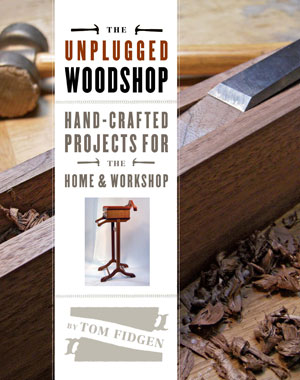
As he moved away from boat building, the projects Tom built at first were “utilitarian, stuff people needed,” like built-ins or kitchen cabinets. He has since built projects like a side table, with a Shaker -based design with Arts and Crafts elements, from ash driftwood; a Gentleman’s Valet; and a “Funeral Chair” — so named, according to the information in Tom’s newly released book, The Unplugged Woodshop, possibly due to their use by the influx of mourners in the days of home funerals. “It’s a simple folding chair, and it’s something I really enjoy,” Tom said. “It can be made by intermediate to advanced woodworkers; you can change subtle details to suit your experience.”
“I enjoy making tools as well,” Tom said. “It’s kind of fun. I like to challenge myself and not just open the history book and do it the way they did it 200 years ago, but maybe do something different. It challenges me and keeps it exciting and interesting.” Included in his book are plans for making hand tools, such as a plane or a frame saw, using hand tools.
As for the tools in his shop, Tom said, “My favorite go-to plane is a smoothing plane made for me by James Krenov. It’s my prize possession.” While he might have a few old tools, “I welcome modern hand tools,” noting that he appreciates those from Lee Valley, a Canadian company: “If you have a tool company in your backyard, you should probably support them.”
When it comes to supporting other woodworkers, in addition to his books (The Unplugged Woodshop is published by The Taunton Press, ISBN 978-1-60085-763-8), Tom has also been teaching classes for about four years. About 60 percent of his students are beginners and, “when I first started, I would say it was about 75 percent retired men who wanted to come over and talk about hand tools. Something happened about a year ago, and now it’s about 80 percent women who are interested in woodworking or just getting into woodworking.”
Mostly, Tom said, he teaches an introduction to hand tools, more techniques than projects. He’ll also be teaching in 2014 at the Rosewood Studios in Perth, Ontario. With his students, Tom said, he’s taken back regularly to “the first time someone hand planes a surface of a board” and is in awe of the the effect they can achieve. “Once you start doing it, you kind of take it for granted,” he said. “I’m reminded of it every day, and it keeps the passion alive. It reminds me of how amazing it can be working with hand tools and working with wood.”
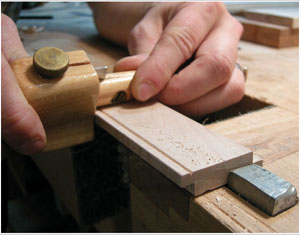
When in Toronto, the woods Tom works with are mostly oak and walnut, which “grow like crazy” in Ontario, he said. In Cape Breton, where he still spends two months out of the year, it’smostly maple and birch. “I like to use local woods, and it’s not just because I like to shop locally. It’s also stability. If the wood grows in the backyard and I work it there and it’s going to live there, it’s a whole lot more stable than if I have it shipped in, in terms of relative humidity and wood movement.”
As he had worked with wood over the years, “you get your head around how wood works,” Tom said. Tying in his woodworking with his musical career, he notes that a guitar is on his bucket list of things to build, but that “a box is a box, whether it’s a guitar or a side table. I feel really confident I could build whatever I wanted to build.”
